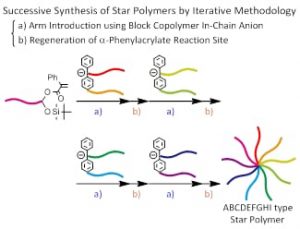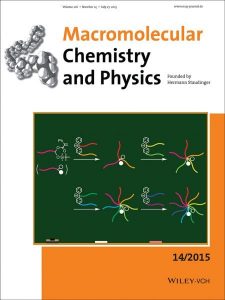 Block copolymers often produce nanometer-sized three-dimensional microphase-separated ordered structures in bulk or in solution due to the immiscibility of different polymer segments. Since such nanostructures possess the different properties derived from the polymer segments, they are currently playing an important role in the field of nanoscience and nanotechnology.
Block copolymers often produce nanometer-sized three-dimensional microphase-separated ordered structures in bulk or in solution due to the immiscibility of different polymer segments. Since such nanostructures possess the different properties derived from the polymer segments, they are currently playing an important role in the field of nanoscience and nanotechnology.
Although numerous block copolymers with precisely controlled structures have recently been synthesized by various living/controlled polymerization systems, such as anionic, cationic, and radical polymerizations, the synthesis of block copolymers with branching point(s) like star-branched polymers is still challenging, because multistep reactions are required to obtain such polymers with high homogeneity.
 Prof. Akira Hirao and co-workers have reported the precise synthesis of multi-armed and multi-component star-branched polymers using living anionic polymerization. For the synthesis, they have developed a new concept using an iterative approach, in which a polymer chain is introduced, followed by the regeneration of the same reaction site for the introduction of the next polymer chain. By repeating the iterative process, the number of polymer chains in the star-branched polymer can be successively, and in principle, limitlessly increased. Furthermore, the use of block copolymers with a living anion between the blocks for the introduction of the polymer chains makes the entire synthetic route quite short, which enables the synthesis of multi-armed and multi-component star-branched polymers readily and efficiently.
Prof. Akira Hirao and co-workers have reported the precise synthesis of multi-armed and multi-component star-branched polymers using living anionic polymerization. For the synthesis, they have developed a new concept using an iterative approach, in which a polymer chain is introduced, followed by the regeneration of the same reaction site for the introduction of the next polymer chain. By repeating the iterative process, the number of polymer chains in the star-branched polymer can be successively, and in principle, limitlessly increased. Furthermore, the use of block copolymers with a living anion between the blocks for the introduction of the polymer chains makes the entire synthetic route quite short, which enables the synthesis of multi-armed and multi-component star-branched polymers readily and efficiently.
In practice, a 9-arm and 9-component star-branched polymer with precisely controlled structure has been successfully synthesized by the iterative methodology for the first time. With this methodology, the introduced arm segments can be controlled in kind and number, giving control over the star-branched architecture. These multi-armed and multi-component star-branched polymers are considered as the next-generation multiphase polymers.

















